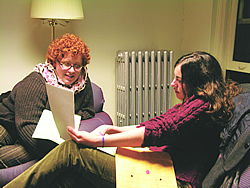|
Issue Contents :: Around Tappan Square :: [ 1 2 3 4 ]
A Student Perspective
by Katie Hubbard ’05
I began teaching an ExCo class almost by accident. During the fall of my sophomore year, I received an e-mail encouraging creative writing majors to teach an ExCo on creative writing. Since the department is relatively small, there is a high demand for the 12-person workshops, and an ExCo would offer another opportunity—outside departmental restrictions—for people to study writing. I decided to take advantage of the offer and convinced my friend and classmate Kat Davis to teach a course with me.
ExCo began at Oberlin in 1968 as a foray into alternative education. The tradition carries on today, bringing together students, faculty members, and townspeople in a self-designed educational environment. Anybody can teach an ExCo on any subject of their choosing, provided they “demonstrate expertise and enthusiasm.”
 |
 |
| |
Seniors Katie Hubbard and Kat Davis |
To undergo the mental switch from student to teacher,
Kat and I thought about our own experiences in the classroom: what
we had learned, how we had learned it, and what teaching techniques
had been most valuable. It was an empowering exercise, one that helped
us develop a syllabus for our own class.
That September, during the
ExCo sign-up fair, Kat and I waited excitedly for our future students
to materialize. And they did. For a class ideally suited for 12
students, 50 enrolled.
Suddenly we were put in the unanticipated position of having to reject students, so we came up with an application form. Many of our final candidates were selected for their sheer creativity or for their daring answers to our questions. A female student composed a story about a young woman whose life spiraled out of control when she wasn’t admitted to the ExCo she most wanted; another student promised that despite rain, snow, thunder, or UFOs, our class would be his priority. Others chose to share their very personal reasons behind their desire to write. Our impromptu application turned out to be an excellent way of getting to know our students even before our first class.
Next, Kat and I had to face our own anxieties. We would be teaching published writing to a group of students—half of whom were older than we were. In the end, however, age was a non-issue; our workshop was about learning and discussion, not about asserting knowledge or superiority. Part of what is so valuable about ExCos is that they challenge traditional notions of who is qualified to teach whom, creating a wider spectrum in which learning can take place.
Over the semester we developed a sense of which teaching and discussion techniques worked the best. We also learned that our individual strengths in the classroom complemented each other. I was more experienced in writing poetry, while Kat preferred writing fiction, so we taught both. As it turned out, the team teaching system worked well for other reasons, too. If one of us lost our train of thought, the other jumped in. If students had a hard time understanding something one of us tried to explain, the other would consider the concept from a different angle. We also had differing reactions to the students’ pieces, which illustrated the wide range of possibilities and aesthetics in creative work.
This semester, as seniors, Kat and I are once again teaching the Creative Writing ExCo. The class is more cohesive this year, and we are learning that teachers have good days and bad days; we found ourselves at a loss recently while teaching Wallace Stevens’ poem Thirteen Ways of Looking at a Blackbird. For some reason, the students found the poem hard to access, and the more Kat and I tried to communicate our own excitement, the more confused they became. We taught the same poem much more successfully two years ago. But instead of giving up, Kat and I brainstormed new ways of talking about the poem in case we ever have the opportunity to teach it again.
The most exciting aspect of teaching, by far, is watching students suddenly grasp the material. Recently, a student turned in a free verse sonnet that was far better than any of his previous work. “You’ve had a breakthrough! How exciting!” I wrote on his paper. Kat and I read that poem to each other over and over, thrilled that we had somehow been part of his development as a writer.
Love a
Parade?
Should purple monsters and tomatoes with eight legs walk down the street like everyone else? If so, organizers of Oberlin’s Big Parade and Festival are looking for you!
The 2005 festival, scheduled for Saturday, April 30, continues a three-year tradition of celebrating Oberlin’s town/gown relationship. A parade, music, and artistic performances by Kendal-at-Oberlin residents, the MAD (Music, Art, Drama) Factory, Oberlin schools, and other College and community groups serve as a great way to show off Oberlin pride in a family-friendly way.
Alumni with artistic abilities are invited to host a workshop or lecture on building floats, masks, art cars, and other parade-worthy objects. For information, contact senior Allison Shauger at Ashauger@oberlin.edu.
|





